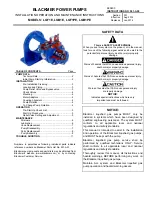
Hydraulic installations
Design of the system
17
© Lutz-Jesco GmbH 2017
Subject to technical changes.
170502
BA-10010-02-V01
Solenoid-diaphragm dosing pump
MAGDOS LA / LD
Operating instructions
8 Hydraulic installations
In this chapter, you will find information about the hydraulic parts of a
system that you should install or that can install additionally. In many
cases, you must install hydraulic accessories to be able to use all the
functions that the dosing pump offers, to guarantee functional safety or to
achieve a high level of dosing precision.
WARNING
Caustic burns or other burns through dosing media!
A diaphragm rupture, blocked pressure lines or the use of material not
suitable for the dosing medium can result in the discharge of dosing
medium. Depending on the type and hazardousness of the dosing
medium, this can result in injury.
ð
Wear the recommended personal protective equipment.
ð
Make sure that the materials you are using are suitable for the
dosing medium.
ð
Make sure that the lubricants, adhesives, sealants, etc. that you
use are suitable for the dosing medium.
ð
Install a leakage drain.
ð
Install pressure relief valves.
CAUTION
Danger of personal injury and material damage!
High peak pressures can lead to piping vibrating and cause them to
snap. This can result in injury from piping or escaping dosing media.
ð
Install pulsation dampeners.
NOTE
Damage to drives due to overloading
The pressure conditions between the suction and discharge sides
must be balanced; otherwise, overloading can result. This can lead to
uncontrolled dosing processes, damage to the piping and to the
dosing pump.
ð
Ensure that the pressure on the discharge side is at least 1 bar
than on the suction side.
NOTE
Locking of threads
Stainless steel and plastic parts (particularly those made of PVC) that
are bolted together in a detachable connection (e.g. the dosing head
and the valves) can lock. This makes them difficult to release.
ð
Before bolting, grease the corresponding parts with a lubricant
(e.g. PTFE spray). Ensure that the lubricant is compatible with the
dosing medium.
8.1 Design of the system
n
The dosing pump s technical data must be taken into account and the
plant s layout must be set up appropriately (e.g. pressure loss when
rating the lines with regard to their nominal diameter and length).
n
The entire system and its integrated dosing pump must be designed
in such a way that an escaping dosing medium (due to the failure of
wearing parts such as the diaphragm, or burst hoses) does not lead to
permanent damage to system parts or the premises.
n
The leakage opening of the dosing head must be visible so that you
can detect a diaphragm rupture. It must be possible for the outflow
from the leakage drain to be on a free downwards gradient.
n
If you use hazardous dosing media, the installation must be designed
such that no disproportionately high consequential damages arise
due to dosing media escaping.
n
To avoid dosing errors after the end of the process, the dosing pump
must be locked hydraulically.
n
To allow you to easily inspect the pressure conditions in the system,
you should provide connections for pressure gauges close to the
suction and pressure valves.
8.2 System piping
n
The system piping must not exert any force on the connections and
valves of the dosing pump.
n
This means that steel piping should be connected to the dosing pump
by means of flexible pipe sections.
n
The nominal diameters of the pipework and the installed fittings
should be rated the same as or greater than the nominal diameters of
the dosing pump's suction and pressure valves.
n
The suction line should be kept as short as possible.
n
You should avoid intertwined hoses.
n
Avoid loops, since air bubbles can collect.
Содержание MAGDOS LA
Страница 2: ......
















































